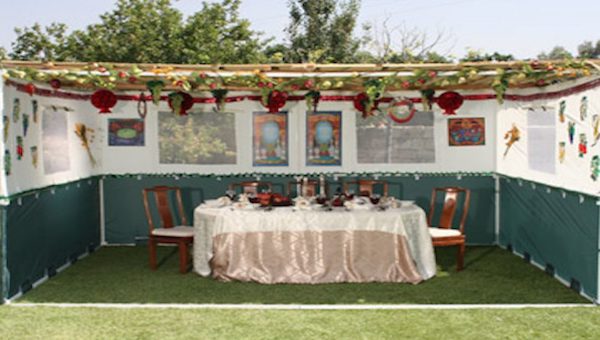The Jewish festival of Sukkot begins at sundown Monday, 9/20. Sukkot is one of the three most important Jewish festivals (the other two are Passover and Shavuot). I know what some of you are thinking, and the answer is no, the other Jewish festivals like Chanukah and Purim were created by ancient Rabbis. So they are not as important. The other major Jewish festival, my birthday, was created by a Jewish blogger looking for an excuse to have ice cream cake. Sukkot Sukkah
It is important to note that the five-day period after Yom Kippur leading up to Sukkot are the Jewish calendar’s most dangerous days. Those days aren’t hazardous because God starts zapping those who didn’t make it into the book or iPad of life on Yom Kippur. It’s dangerous because that’s the one time each year some Jewish men using tools.
To prepare for the holiday of Sukkot, during those five post-Yom Kippur days, Jews all across the world start building their Sukkahs. We wait till after Yom Kippur because we don’t start preparing for one holiday until the previous one is over. The five days may become four when like this year, Shabbos occurs during that period. Just as John Goodman’s character in the Big Lebowski, Walter Sobchak didn’t roll on Shabbos. We don’t build on Shabbos.
A Sukkah is a flimsy hut used for the Holiday. How flimsy? Imagine if Ikea made houses—a Sukkah is much more fragile.
Most Jews aren’t great with tools. For many of us (like yours truly), the last time we picked up a tool or stepped on a ladder was when we took down last year’s Sukkah. So you can probably have a belly laugh if you peek out your window and observe your Jewish neighbor building their Sukkah–it is the construction equivalent of the Keystone Kops, and you can hear them cussing in ancient foreign tongues. One of my neighbors even swears in Klingon.
Sukkot is celebrated for eight days (sort of) in the diaspora and seven in Israel. The reason for the “sort of” is that the last two days are actually different holidays Shemini Atzeret and Simcha Torah (more on that later).
Sukkot is a happy holiday. In Hebrew, it is referred to as Yom Simchateinu (the day of our rejoicing) or Z’man Simchateinu (the time of our rejoicing). Our happiness has nothing to do with the fact that we are allowed to eat after fasting on Yom Kippur. Nor is it that we’ve been able to put down our hand tools without any significant damage to our bodies (sometimes).
A Sukkah must have a semi-see-through roof–that must be built from something that grows in the ground (NO, not mold or insects). That roof is called sechach. It’s a very helpful word. Sukkot usually occurs at the beginning of the fall. During the holiday, Jews will eat their meals outside (some will even sleep outside). Saying the word sechach over and over during the holiday allows us to politely clear our throats from the congestion without appearing to call up a loogie.
My friend Eddie is a rare American Jew—good with tools. He built his Sukkah from scratch using raw materials. He is what’s known in Hebrew as שוויצר, which translates as “freaking show-off.” As for me, I put together a pre-fabricated Sukkah, which sadly doesn’t save my fingers from injury when trying to pound the metal frame together.
By the way, do you want to know how some Jews get lights for our Sukkahs? Have you ever gone into a Walmart 2-3 weeks after Christmas? The store sells left-over Christmas lights for $1.99 a case? The guy you see in the parking lot wheeling the extra-large shopping cart filled with boxes of Christmas lights might very well be a Jew who bought them to light the Sukkah. I guess some can say Sukkot is the one Jewish holiday with the “Christmas Spirit.”
My favorite part of Sukkot is inviting friends over and hanging out in the Sukkah. It seems less pressured than when they come into the house and hang out because if we drop something, it doesn’t matter. We are outside. And this year, under COVID restrictions, people don’t have to wear masks, providing that our Sukkahs are big enough to socially distance.
BTW if you are invited to hang out in a Jewish friend’s Sukkah, please don’t say you are celebrating nomadic hut appreciation week–it’s really not nice.
Speaking of guests, there is a tradition called ushpizin. In this mystical tradition from the Kabbalah, we invite a different biblical hero to be a guest in our Sukkah each night of the holiday. The guests are Abraham, Isaac, Jacob, Moses, Aaron, Joseph, and David. I suspect we don’t invite the Prophet Elijah because he is still nursing a hangover from having a glass of wine at every Passover seder across the world. Please note while other guests may bring flowers, wine, desserts, etc., these biblical guests bring nothing, so don’t expect anything. On the other hand, they don’t eat anything, but that’s not the point.
The holiday of Sukkot reminds us of the life of the ancient Israelites wandering in the wilderness for 40 years living in structures just like the Sukkahs we build for the holiday, hence the flimsiness. The Jews also argued over whether Moses should stop at a gas station to ask for directions in the wilderness.
Existing in this kind of flimsy structure reminds us of the frailty and transience of life and, in the end, our necessary dependence on God to protect us. In modern times we cook our own food, but when we were in the wilderness, we ate manna. Why is it called manna? Exodus Chapter 16 verse 15 says, explains “And when the children of Israel saw it, they said one to another: ‘What is it?’ –for they knew not what it was.” In other words, for forty years, we ate food sent from God but kept asking, “what is this crap?”
Sukkot is also a holiday that reminds us of the Jewish connection to Israel. We spent forty years living in those flimsy structures trying to get to the holy land because those newly freed Jewish slaves knew that they belonged in the holy land. In modern times Jews only live in those huts one week every year, but we should also remember the goal of those forty years of wandering was to return to the holy land that Jacob and his sons left two hundred and ten years before. They weren’t called Zionists back then, but that’s what they were.
Sukkot has other significant meanings, perhaps the best one for today’s world. Sukkot that it is the Holiday when we pray for the rest of the world, and considering how the world’s looked lately, that’s a good thing. In Biblical times, the High Priest sacrifice 70 bulls during Sukkot. This represented one prayer for each of the 70 Goyim (nations) of the world. I would imagine that the period before Sukkot was also a period of prayer for those 70 bulls about to be sacrificed.
BTW some historians believe that the first Thanksgiving was modeled after Sukkot.
From building the Sukkah and “living in it’ for a week to tearing it down, Sukkot is a fun and joyous time we share with family and friends, both Jewish and Gentile.
Sukkot is celebrated for seven days (sort of) in the diaspora. The reason for the “sort of” is each of the two days after Sukkot are also holidays: Shemini Atzeret and Simcha Torah (more on that later).
Shemini Atzeret celebrates our love for God, his relationship with the Jewish people and adds a special prayer for rain (Geshem). The rain prayer is for the holy land. It’s not needed here in the U.S. because, during Sukkot, there is usually a strong rainstorm/windstorm that blows our Sukkah from our patio onto its side in the grass. Perhaps it’s God’s way of making all Jews everywhere feel like N.Y. Jets fans—blowing success at the last minute.
Simcha Torah is another fun day. Jews read the last chapters of the Torah and then the first chapters.
SPOILER ALERT: The Torah ends with Moses dying.
Judaism teaches that studying Torah is a continual life-long process. That is why on Simcha Torah, we read the last chapter of the Torah (the death of Moses), and immediately rewind the Torah scroll and read the creation story at the beginning of the Torah.
Simcha Torah is a fun gala where we sing, dance with the Torah Scrolls, wave flags, etc. (and drink).

A Lulav
There’s one more important part of the Sukkot celebration, the Lulav, and the Etrog, also known as the four species. The lulav is a palm branch, joined with myrtle and willow branches (see above), and the Etrog is citron fruit. It kind of looks like a lemon that suffers from boils. The four species are held and waved during various parts of the Sukkot services.

The Very Ugly Etrog Fruit
Sukkot starts Monday night at sundown. Monday night, along with every first night of Sukkot, is a full moon.
This year, maybe every one of any faith can join us in praying for the safety of the people of all nations. Especially praying that God eliminates the COVID mess.
As we say in Hebrew: Chag Samayach!
חג שמח
Whether you are Jewish or Gentile, Have Joyous Sukkot
https://www.facebook.com/jeffrey.dunetz
Sukkot Sukkah
Sukkot Sukkah
Sukkot Sukkah
https://lidblog1.wpenginepowered.com
gentiles guide Sukkot
gentiles guide Sukkot
gentiles guide Sukkot
gentiles guide Sukkot






